I am currently reading “Ghosts of Spain: Travels Through a Country’s Hidden Past”, by Giles Tremlett, a British journalist who’s made Madrid his home. I have just read the chapter on corruption. The King Juan Carlos, who was a supported of Franco, became head of state after the dictator’s death, and then he ushered in democracy by declaring a constitutional monarchy, effectively giving up all his power to form a democratic parliament. Like most revolutions, those who manage the new countries tend to be those who were managing the old one. Many politicians, civil servants and judges who worked under Franco and celebrated him as the Generalissimo were the same to be the torch bearers of democracy – at least publicly and several years after Franco’s death. The first party to be voted in was a socialist one, and they remained in power for 14 years. They were ousted in 1996 following many uncovered corruption cases (thanks mostly to the work of the socialist magistrate Gurzon). Corruption in Spain, Tremlett explains, usually involves construction companies.
It is rather auspicious that we should land in the port of Adra after having read Tremlett’s chapter on corruption. Our berth neighbours in Cartagena, a French couple who come from the same region as Pierrick, had first told us about it. They told us how they had arrived in this abandoned port. Like a sort of ghost port. They were greeted by a man who told them that they could stay for the night, use the water and electricity, for 10 EUR. Now, if 40 EUR/night is cheap, 10 EUR/night is unheard of! In any case, we were headed that way and the coast offers very little shelter in the form of calas, or bays, so we decided to stay there for a night.
The last edition of our guidebook was published in 2014. It describes Puerto de Adra as a working harbour, “A rather desolate commercial and fishing harbour.” It goes on to explain that “A new marina is planned but no information is yet available.” On its map, the new marina is drawn under the words “Work in progress.”
We saw upon arrival that several pontoons of the “work in progress” marina were occupied by local small motor boats. I asked one man at his boat if we could dock in the marina. He told me that the section where his boat was all had occupants but that we can dock in the empty section. “It’s abandoned,” he said. The abandoned area was equipped with two long pontoons made to accommodate larger boats like ours. Each spot was supplied with an electricity and water outlet. A thin rope was tied from one outlet to another, with an occasional piece of white plastic tied to it like a small flag. The end of the pontoons was closed off by a gate that was locked shut.
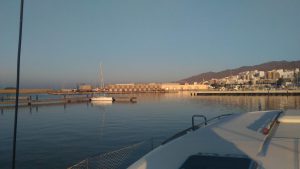
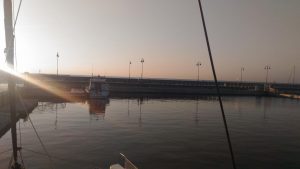
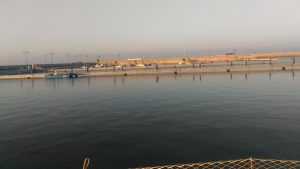
To avoid being locked onto a pontoon we docked along the Muelle de Ribera. Its pontoon was 2m below street level and gave onto an improvised walkway that was separated from the street by a vacant lot. It was covered in shattered glass and dog poop. No marinero came to see us. I scouted the area for some sort of port officials but found nothing but dog-walkers. So we hooked up our water hose to clean the boat, which Pierrick did while I went for a run.
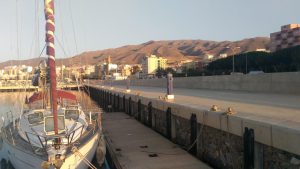
Running in cities helps me get my bearings. It’s my way to explore the surroundings and try to understand where I am. Running through Adra I saw many elderly and families with small children. Clearly this is not a university town. I saw a good proportion of women in headscarves and a population that was over rather than under weight. Whereas the seaside front of Tarragona is filled with runners and cyclists, I encountered only one other runner along my half hour route. I passed along the main commercial street where there were supermercados and zapaterias and peluquerias, yet none of them bore a name I recognized. The town has no Zara store. Its streets look like backstreets. Some buildings and parking lots give directly on the crude mountain slope behind it. It is, quite obviously, a poor city.
I reckon the marina was meant to bring tourists. In any case, its construction, most likely made possible by European Union funds, created jobs in the area. The renovation works involved the creation of two huge jetties, the Dique de Poniente and the Dique de Levante. Combined, these two diques completely protect the existing fishing harbor and Nautical Club — for members only. One can presume that the renovation works were meant to please existing club members. Or, that the construction work was done but the new marina never opened for lack of funds. The European Union sponsors construction on a per-project basis and gives funds according to expected costs. Why did funds run out? Were funds pocketed? Might the port of Adra be an example of Spanish-style corruption? One thing is for sure, it is not the population of Adra that would occupy the port with leisure boats. Theirs are the small motor boats that they use to go fishing, sport that offers a free meal.
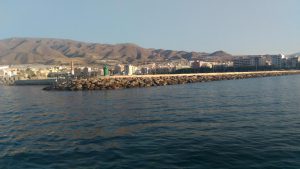
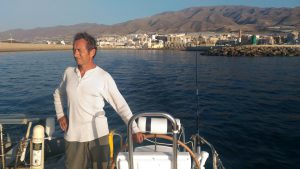
All along Spain’s West Coast, the land is either bare slopes or over-developed seaside towns populated by Northern European tourists and expats. Not so along the Southern, Africa-facing coast. Any flat land between the sea and the mountains is used for agriculture. Long white sheets of plastic cover the fields, creating semi-permanent greenhouses. The fruits and vegetables grown here are those eaten by Northern Europeans in the winter time. In this area there does not appear to be much industry apart from agriculture. Who today works in agriculture, an essential yet usually ill-paid industry?
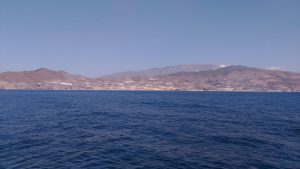
Yesterday while sailing to Adra we heard another emergency message. A pneumatic boat with 29 people in it was adrift, having left the Moroccan coast for the Spanish one. This was following a similar message on 20 September of a boat adrift with 52 people in it. What do these people do once they arrive in Spain? I expect many stay along the southern coast working (declared or not) in the fields. They live in shanty apartment blocs in poor working-class towns like Adra and on good days, when the sky is clear and visibility is good, they can see all the way to Africa, and see how far they’ve come.
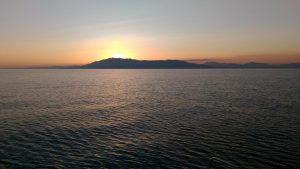
Our current guidebook is “Mediterranean Spain – Costas del Sol and Blanca – Straight of Gibraltar to Cabo de la Nao,” by Graham Hutt, 7th Ed, 2014, published by Imray.